<< Previous | Displaying results 4976-5000 of 6769 for "" | Next >>
Athletes Jesse Owens of the United States (right) and Lutz Long of Germany at the Olympic stadium. Berlin, Germany, 1936.
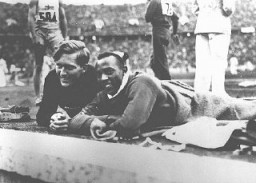
Members of the US Olympic team—runners Helen Stephens and Jesse Owens—at the Berlin Olympic Games. Germany, August 1936.
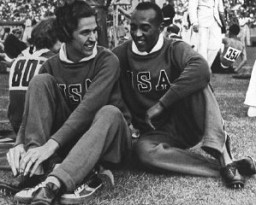
During the 1936 Olympics in Berlin, US runner Jesse Owens begins the 200-meter race in which he established a new Olympic record of 20.7 seconds. Berlin, Germany, August 2, 1936.
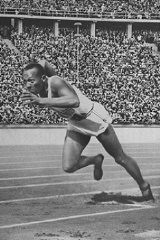
Repairs and improvements are made to the courtroom where the International Military Tribunal trial of war criminals would be held. The holes in the walls at the top (when completed) housed radio commentators and public address operators. September 11, 1945.
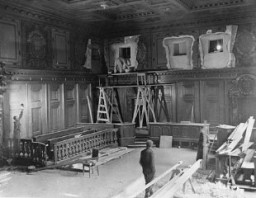
The courtroom in the Palace of Justice, chosen as the location for the International Military Tribunal trial of war criminals. This photograph shows the courtroom before any repairs or alterations were made. Nuremberg, Germany, August-September 1945.
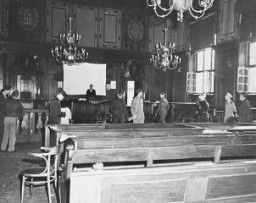
View during the remodeling of the Palace of Justice in Nuremberg in preparation for the International Military Tribunal. Nuremberg, Germany, 1945.
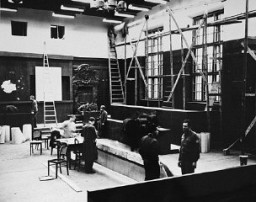
View of the interpreters' section in the courtroom during the International Military Tribunal. Nuremberg, Germany, March 29, 1946. The Nuremberg trials were an early experiment in simultaneous translation. The charter of the International Military Tribunal stated that the defendants had the right to a fair trial and that, accordingly, all proceedings be translated into a language that the defendants understood.
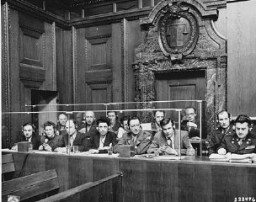
View of the Palace of Justice (left), where the International Military Tribunal trial was held. Nuremberg, Germany, November 17, 1945. The Palace of Justice was selected by the Allied powers as the location for the International Military Tribunal (IMT) because it was the only undamaged facility extensive enough to accommodate a major trial. The site contained 20 courtrooms and a prison capable of holding 1,200 prisoners.
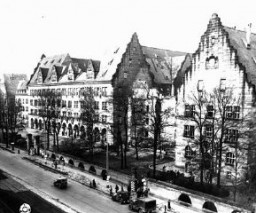
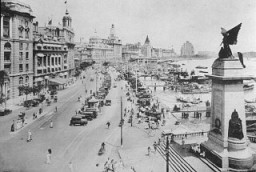
German Jewish refugee Erwin Eisfelder stands outside Cafe Louis on Ward Road. The cafe was named in honor of his father. It was a popular gathering place for refugees in Shanghai during the war years. Shanghai, China, ca. 1944.
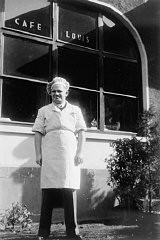
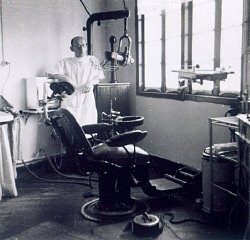
German Jewish refugee artist David Bloch. In November 1938 Bloch was interned for several weeks in the Dachau concentration camp near Munich. With the help of his brother in the United States, he escaped from Germany to Shanghai in May 1940.

Two German Jewish refugee women stand behind the counter of the Elite Provision Store (delicatessen) in Shanghai. Pictured on the left is the owner, Gerda Harpuder; on the right is her cousin Kate Benjamin. In 1939 Hans and Gerda Harpuder sold their crystal, silver, and other family possessions shipped from Berlin in order to open a grocery store in Hongkew at 737 East Broadway.
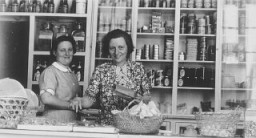
Photograph of Jan Zwartendijk with his daughter Edith and son Jan, Jr., Kovno, 1939-1940. Zwartendijk aided Jewish refugees by issuing permits for them to enter Curaçao, a Dutch colonial possession in the West Indies.

Yitzhak Gitterman (left), Joint Distribution Committee (JDC) director in Warsaw, meets with the representative of an Orthodox Jewish organization. Warsaw, Poland, date uncertain.
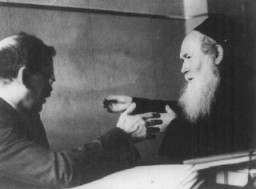
American military police admit a father and daughter, both displaced persons, to the refugee shelter at Fort Ontario. Oswego, New York, United States, after August 4, 1944.
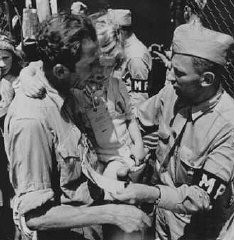
Jewish refugees from Europe arrive at the emergency refugee shelter at Fort Ontario, in the United States. A father, holding his daughter, checks his tags. Oswego, New York, United States, August 4, 1944.
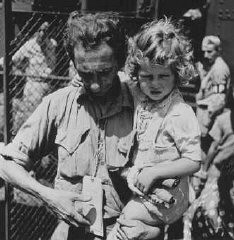
Portrait of John Pehle, Executive Director of the War Refugee Board. United States, 1940s.
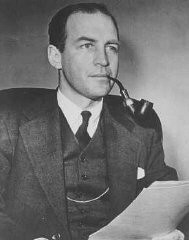
Meeting of the War Refugee Board in the office of Executive Director John Pehle. Pictured left to right are Albert Abrahamson, Assistant Secretary of the Treasury Josiah Dubois, and Pehle. Washington, DC, United States, March 21, 1944.
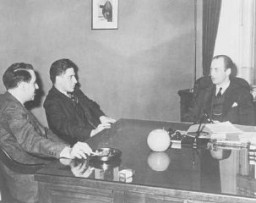
Photo taken in Secretary of State Cordell Hull's office on the occasion of the third meeting of the War Refugee Board. Hull is at the left, Secretary of the Treasury Henry Morgenthau, Jr., is in the center, and Secretary of War Henry L. Stimson is at the right. Washington, DC, United States, March 21, 1944.
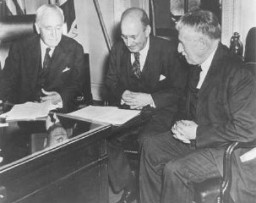
An aerial view of the Nuremberg prison, where defendants in the International Military Tribunal war crimes trial were held. Photograph taken in Nuremberg, Germany, between October 1945 and October 1946.
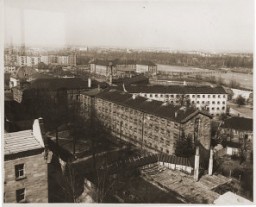
At the time of the International Military Tribunal, the city of Nuremberg reflected the devastation of war, as did much of Europe. This landscape of destruction stands in stark contrast to the Nazi rallies held in Nuremberg only years earlier.
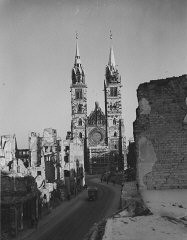
View of the bombed-out city of Nuremberg. Visible in the distance is the twin-spired Lorenz Church, and on the right, a statue of Kaiser Wilhelm I. Nuremberg, Germany, 1945.
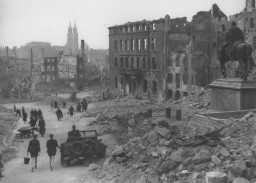
The inhabitants of Nuremberg watch a parade of US troops through their city. Nuremberg, Germany, 1946.
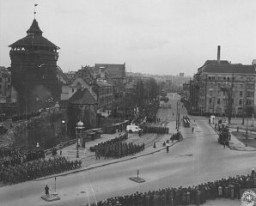
Among the many ironies of the International Military Tribunal was that the defendants were accorded that which they had denied their opponents: the protection of the law and a right to due process. Here, defendant Walther Funk, former German Minister of Economics, speaks with his defense attorney, Dr. Fritz Sauter, in a visitation room at Nuremberg.
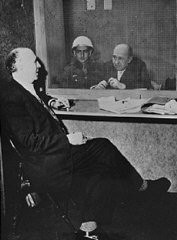
We would like to thank Crown Family Philanthropies, Abe and Ida Cooper Foundation, the Claims Conference, EVZ, and BMF for supporting the ongoing work to create content and resources for the Holocaust Encyclopedia. View the list of donor acknowledgement.